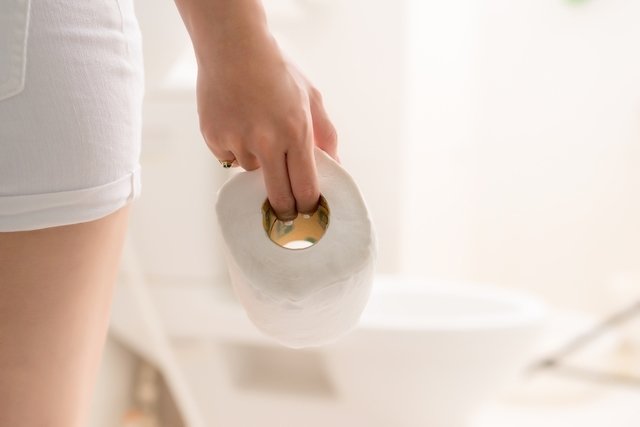Treatment for external hemorrhoids can be done with home measures such as warm water sitz baths, increasing fiber intake and drinking more water, as they help to alleviate discomfort at home.
However, it is important to consult a proctologist to start using anti-inflammatory medications or ointments which, in addition to relieving pain and discomfort, also allow hemorrhoids to be reduced and healed more quickly. See other symptoms of external hemorrhoids and their causes.
Furthermore, when hemorrhoids are very large or appear frequently, the proctologist may recommend surgery, but generally the use of medicines prescribed by the doctor together with home measures are quite effective, without the need for surgery.

9 treatments for external hemorrhoids
To control hemorrhoids, the main treatment options include:
1. Sitz bath
Warm water helps to relieve swelling and pain, but it should only last about 15 to 20 minutes and can be done several times a day.
Some medicinal plants that can be added to the basin with warm water are chamomile, lavender, arnica and witch hazel, which will help to calm the area, relieving pain in a few minutes.
But to prevent the area from becoming infected, it is recommended to use a stainless steel basin that is properly cleaned and disinfected with 70% alcohol, and the water must be changed after each sitz bath.
2. Eat more fiber
Eating foods rich in fiber at every meal, such as whole grains, leafy vegetables and fruits with skins, is also an excellent way to soften stools, causing less discomfort during evacuation.
Some examples of recommended foods are figs, papaya and oats, but it is also possible to add water-soluble fiber, such as Metamucil or Muvinlax, which can be purchased at the pharmacy. Just mix 1 dessert spoon or 1 sachet of this powder in 1 glass of water, soup or juice and take it with every meal.
Read too: Diet rich in fiber: how to do it (with menu)
3. Drink more water
Drinking more water is important to make your stools softer, and is especially important when increasing your fiber intake.
Furthermore, if this care is not taken, the effect of the fibers may be the opposite and the stools may become even harder and more difficult to pass, worsening the hemorrhoids.
4. Use a laxative
Another option to help soften the stool and prevent the external hemorrhoid from worsening or causing more pain when having a bowel movement, the proctologist may recommend the use of laxatives, such as docusate, for example.
Thus, softer stools reduce straining and excessive pressure when evacuating, allowing external hemorrhoids to shrink and return to their natural state.
5. Apply cold and warm compresses
Applying cold compresses for 10 minutes and then warm compresses for 15 minutes, 3 times a day, can help reduce inflammation and ease the discomfort of hemorrhoids.
This is because the cold promotes vasoconstriction and the light heat promotes blood circulation in the area, reducing pain.
The compresses must be applied with a clean cloth or gauze to the region and discarded each time they are used.
6. Use hemorrhoid ointment
Ointments for hemorrhoids, such as Proctyl or Ultraproct, may be recommended by the proctologist, as they help to reduce the size of the external hemorrhoid and relieve pain in a few minutes.
These ointments should only be used if recommended by the proctologist, according to the symptoms presented, they are normally applied to the external hemorrhoid region while there is pain and discomfort.
7. Home remedies
An excellent home remedy for external hemorrhoids is sitz baths, but it is also possible to make a homemade hemorrhoid ointment, such as witch hazel ointment, for example. See how to correctly prepare home remedies for hemorrhoids.
Watch the following video with other home remedy options for hemorrhoids:
8. Hemorrhoid pills
Medicines in the form of pills for hemorrhoids, such as paracetamol and ibuprofen, can be used to relieve pain, and under medical supervision.
Furthermore, the proctologist may recommend the use of medicines such as Daflon or Perivasc, to relieve swelling, pain and bleeding caused by hemorrhoids. Diabetics should only use hemorrhoid medications under medical advice.
Generally, external hemorrhoids ease soon after following these treatments, disappearing within 2 or 3 days, but in more serious cases, when there are no signs of improvement, surgery may be necessary.
9. Hemorrhoid surgery
Surgery for external hemorrhoids is only indicated in the most serious cases, when the hemorrhoid suffers thrombosis or ruptures, as generally with the use of ointments, sitz baths and food, the external hemorrhoid disappears. Learn more about hemorrhoid surgery.
However, after surgery, you should continue to eat a diet rich in fiber and avoid straining when having a bowel movement to prevent the appearance of new hemorrhoids.
Care during treatment
During treatment, the individual must take certain precautions such as:
- Avoid using toilet paper, washing the anal area with soap and water after bowel movements;
- Do not lift weights;
- Do not eat very spicy and spicy foods;
- Do light or moderate physical exercise, which can include walking;
- If necessary, use a hoop-shaped cushion with an opening in the center to sit on.
Another important tip is not to strain to evacuate, as this increases the risk of creating more hemorrhoids.
See the video below for the correct sitting position to facilitate the exit of feces:
Signs of improvement
Signs of improvement in external hemorrhoids include pain relief, especially when sitting and having a bowel movement, as well as a decrease in the swelling of the hemorrhoid and the decrease or disappearance of blood in the bowel movements.
Furthermore, not feeling the external hemorrhoid when palpating it means it is gone.
Read too: Blood in the stool: 9 main causes (and what to do)
Signs of worsening
Signs of worsening external hemorrhoids include increased pain, especially when sitting or having a bowel movement, as well as swelling of the hemorrhoid.
Furthermore, the external hemorrhoid may be larger when the individual palpates it, and may lose more blood during bowel movements.

Sign up for our newsletter and stay up to date with exclusive news
that can transform your routine!
Warning: Undefined array key "title" in /home/storelat/public_html/wp-content/plugins/link-whisper-premium/templates/frontend/related-posts.php on line 12
Warning: Undefined array key "title_tag" in /home/storelat/public_html/wp-content/plugins/link-whisper-premium/templates/frontend/related-posts.php on line 13



